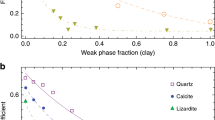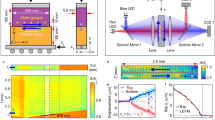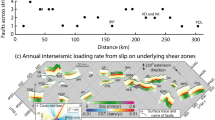Abstract
The seismic cycle requires that faults strengthen (heal) between earthquakes, and the rate of this healing process plays a key role in determining earthquake stress drop1,2,3,4, rupture characteristics5,6 and seismic scaling relations2,3,4,7. Frictional healing (as evidenced by increasing static friction during quasi-stationary contact between two surfaces1,8,9,10,11,12) is considered the mechanism most likely to be responsible for fault strengthening2,3,13,14. Previous studies, however, have shown a large discrepancy between laboratory and seismic (field) estimates of the healing rate2,3,4,14,15; in the laboratory, rock friction changes by only a few per cent per order-of-magnitude change in slip rate, whereas seismic stress drop increases by a factor of 2 to 5 per order-of-magnitude increase in earthquake recurrence interval. But in such comparisons, it is assumed that healing and static friction are independent of loading rate. Here, I summarize laboratory measurements showing that static friction and healing vary with loading rate and time, as expected from friction theory16,17,18. Applying these results to seismic faulting and accounting for differences in laboratory, seismic and tectonic slip rates, I demonstrate that post-seismic healing is expected to be retardedfor a period of several hundred days following an earthquake, in agreement with recent findings from repeating earthquakes13,14,19,20.
This is a preview of subscription content, access via your institution
Access options
Subscribe to this journal
Receive 51 print issues and online access
$199.00 per year
only $3.90 per issue
Buy this article
- Purchase on Springer Link
- Instant access to full article PDF
Prices may be subject to local taxes which are calculated during checkout




Similar content being viewed by others
References
Dieterich, J. H. Time-dependent friction in rocks. J. Geophys. Res. 77, 3690–3697 (1972).
Scholz, C. H., Aviles, C. A. & Wesnousky, S. G. Scaling differences between large interplate and intraplate earthquakes. Bull. Seismol. Soc. Am. 76, 65–70 (1986).
Kanamori, H. & Allen, C. R. in Earthquake Source Mechanics (eds Das, S., Boatwright, J. & Scholz, C.) 227–236 (Am. Geophys. Un., Washington DC, (1986)).
Scholz, C. H. The Mechanics of Earthquakes and Faulting (Cambridge Univ. Press, New York, (1990)).
Heaton, T. Evidence for and implications of self healing pulses of slip in earthquake rupture. Phys. Earth Planet Inter. 64, 1–20 (1990).
Perrin, G., Rice, J. R. & Zheng, G. Self-healing slip pulse on a frictional surface. J. Mech. Phys. Solids 43, 1461–1495 (1995).
Heimpel, M. Critical behaviour and the evolution of fault strength during earthquake cycles. Nature 388, 856–858 (1997).
Johnson, T. Time dependent friction of granite: implications for precursory slip on faults. J. Geophys. Res. 86, 6017–6028 (1981).
Beeler, N. M., Tullis, T. E. & Weeks, J. D. The roles of time and displacement in the evolution effect in rock friction. Geophys. Res. Lett. 21, 1987–1990 (1994).
Nakatani, M. & Mochizuki, H. Effects of shear stress applied to surface in stationary contact on rock friction. Geophys. Res. Lett. 23, 869–872 (1996).
Karner, S. L., Marone, C. & Evans, B. Laboratory study of fault healing and lithification in simulated fault gouge under hydrothermal conditions. Tectonophysics 277, 41–55 ((1997)).
Olsen, M. P., Scholz, C. H. & Léger, A. Healing and sealing of a simulated fault gouge under hydrothermal condtions: implications for fault healing. J. Geophys. Res.(submitted).
Vidale, J. E., Ellsworth, W., Cole, A. & Marone, C. Rupture variation with recurrence interval in eighteen cycles of a small earthquake. Nature 368, 624–626 (1994).
Marone, C., Vidale, J. E. & Ellsworth, W. Fault healing inferred from time dependent variations in source properties of repeating earthquakes. Geophys. Res. Lett. 22, 3095–3098 (1995).
Cao, T. & Aki, K. Effect of slip rate on stress drop. Pure Appl. Geophys. 124, 515–529 (1986).
Dieterich, J. H. Modeling of rock friction: 1. Experimental results and constitutive equations. J. Geophys. Res. 84, 2161–2168 (1979).
Ruina, A. Slip instability and state variable friction laws. J. Geophys. Res. 88, 10359–10370 (1983).
Kato, N., Yamamoto, K., Yamamoto, H. & Hirasawa, T. Strain-rate effects on frictional strength and the slip nucleation process. Tectonophysics 211, 269–282 (1992).
Nadeau, R. M., Foxall, W. & McEvilly, T. V. Clustering and periodic recurrence of microearthquakes on the San Andreas fault at Parkfield, California. Science 267, 503–508 (1995).
Lees, J. M. Microseismic multiplets do not exhibit effects of fault healing at Coso. Eos 77, 502 (1996).
Wang, W. & Scholz, C. H. Micromechanics of the velocity and normal stress dependence of rock friction. Pure Appl. Geophys. 143, 303–316 (1994).
Beeler, N. M. & Tullis, T. E. The roles of time and displacement in velocity dependent volumetric strain of fault zones. J. Geophys. Res. 102, 22595–22609 (1997).
Segall, P. & Rice, J. R. Dilatancy, compaction, and slip instability of a fluid infiltrated fault. J. Geophys. Res. 100, 22155–22173 (1995).
Marone, C., Scholz, C. H. & Bilham, R. On the mechanics of earthquake afterslip. J. Geophys. Res. 96, 8441–8452 (1991).
Rice, J. R. Spatio-temporal complexity of slip on a fault. J. Geophys. Res. 98, 9885–9907 (1993).
Dieterich, J. H. Aconstitutive law for rate of earthquake production and its application to earthquake clustering. J. Geophys. Res. 99, 2601–2618 (1994).
Roy, M. & Marone, C. Earthquake nucleation on models faults with rate and state dependent friction: the effects of inertia. J. Geophys. Res. 101, 13919–13932 (1996).
Biegel, R. L., Sammis, C. G. & Dieterich, J. H. The frictional properties of a simulated gouge with a fractal particle distribution. J. Struct. Geol. 11, 827–846 (1989).
Marone, C. & Kilgore, B. Scaling of the critical slip distance for seismic faulting with shear strain in fault zones. Nature 362, 618–621 (1993).
Beeler, N. M., Tullis, T. E., Blanpied, M. L. & Weeks, J. D. Frictional behaviour of large displacement experimental faults. J. Geophys. Res. 101, 8697–8716 (1996).
Marone, C. Laboratory-derived friction laws and their application to seismic faulting. Annu. Rev. Earth Planet. Sci.(in the press).
Acknowledgements
I thank C. Scholz and N. Beeler for review comments and J. Rice, M. Blanpied and C.Raymo for discussions that helped sharpen my understanding of frictional healing. This work was supported by the US NSF.
Author information
Authors and Affiliations
Corresponding author
Rights and permissions
About this article
Cite this article
Marone, C. The effect of loading rate on static friction and the rate of fault healing during the earthquake cycle. Nature 391, 69–72 (1998). https://doi.org/10.1038/34157
Received:
Accepted:
Published:
Issue Date:
DOI: https://doi.org/10.1038/34157
This article is cited by
-
Earth’s gradients as the engine of plate tectonics and earthquakes
La Rivista del Nuovo Cimento (2022)
-
The Frictional Restrengthening and Permeability Evolution of Slipping Shale Fractures During Seismic Cycles
Rock Mechanics and Rock Engineering (2022)
-
Effect of pore pressure magnitude on the frictional properties and permeability evolution of fractures in schist
Geomechanics and Geophysics for Geo-Energy and Geo-Resources (2022)
-
Laboratory friction-permeability response of rock fractures: a review and new insights
Geomechanics and Geophysics for Geo-Energy and Geo-Resources (2022)
-
Change of crack mode in rock cracking process under quasi-static and dynamic loadings
Geomechanics and Geophysics for Geo-Energy and Geo-Resources (2022)
Comments
By submitting a comment you agree to abide by our Terms and Community Guidelines. If you find something abusive or that does not comply with our terms or guidelines please flag it as inappropriate.



